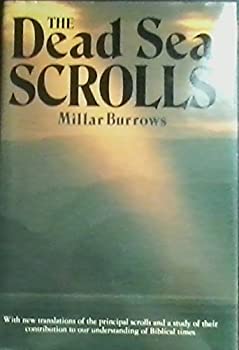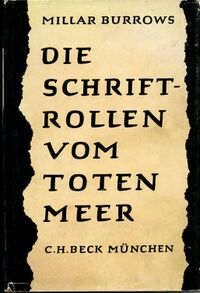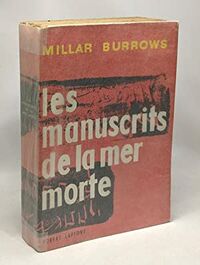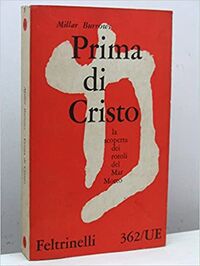The Dead Sea Scrolls (1955 Burrows), book
Millar Burrows The Dead Sea Scrolls (New York, NY: Viking, 1955; and London: Secker & Warburg, 1956).
German ed. : Die Schriftrollen vom Toten Meer = Dead Sea Scrolls (1956 Burrows / Cornelius), book (German ed.)
French ed. : Les manuscrits de la Mer Morte = Dead Sea Scrolls (1956 Burrows / Glotz, Franck), book (French ed.)
Italian ed. : Prima di Cristo: la scoperta dei rotoli del Mar Morto (1957 Burrows / Dell'Oro), book (Italian ed.)
Swedish ed. : Skriftfynden vid Döda Havet = Dead Sea Scrolls (1957 Burrows / Ringgren), book (Swedish ed.)
Spanish ed. : Los rollos del Mar Muerto = Dead Sea Scrolls (1958 Burrows / Speratti Piñero), book (Spanish ed.)
Japanese ed. : 死海写本 = Dead Sea Scrolls (1961 Burrows / Shinmi, Kanō), book (Japanese ed.)
Hungarian ed. : A holt-tengeri tekercsek = The Dead Sea Scrolls (1961 Burrows / József, Komoróczy), book (Hungarian ed.)
Abstract
Burrows was Director of the American School of Oriental Research in Jerusalem when the Scrolls were discovered in 1947. He therefore had the privilege of editing three of the scrolls. Burrows wrote The Dead Sea Scrolls in 1955 when there was still rampant speculation that the Scrolls would dramatically revise traditional interpretations of Christianity. Burrows wrote this text for laypersons and not technical scholars and one of his primary purposes in writing was to assuage this concern. A comprehensive text on the Scrolls, Burrows begins with a complete description of the discovery by Bedouins, continues with problems of dating the Qumran community and the Scrolls, and ends with the significance of the DSS for Judaism and early Christianity. Burrows is one of the early advocates of the Essene Hypothesis (Part Four), which identifies Qumran as an Essene community. This early became the majority viewpoint. The primary importance of the DSS is the insight they offer into “a dissident group of Jews during the time when the temple was standing, just after the composition of the latest books of the Old Testament, and just before and during the time when the New Testament was coming into being” (327). Burrows writes as a Christian scholar and his primary concerns are Christian, but Burrows does recognize the significance of the Scrolls for interpreting Judaism in the century before the common era. Burrows assures the non-technical reader that the Scrolls do not demand any revision of Christian faith. Burrows offers translations of five of the Scrolls in appendices. Burrows followed up this text with More Light on the Dead Sea Scrolls in 1958. - Ronald Ruark, University of Michigan
Contents
- Preface
- A Word to the Wise
- Part One - Discoveries and Discussions
- 1. The First Discoveries
- 2. Alarms and Excursions
- 3. Later Discoveries
- Part Two - The Age of the Manuscripts
- 4. The Evidence of Archeology and Paleography
- 5. The Evidence of Text and Language
- Part Three - The Dates of Composition
- 6. Historical Allusions in the Habakkuk Commentary: The Kittim
- 7. Historical Allusions in the Habakkuk Commentary: Dramatis Personae
- 8. Identifications of Persons and Events
- 9. Historical Allusions in the Other Documents
- 10.Ideas, Vocabulary, and Literary Relations
- Part Four - The Community of Qumran
- 11. Origin, History, and Organization
- 12. Beliefs
- 13. Identification
- Part Five - The Importance of the Dead Sea Scrolls
- 15. Contributions to Textual Criticism, Historical Grammar, and Paleography
- 16. Contributions to the Study of Judaism and Christianity; Summary
- Part Six - Translations
- A. The Damascus Document
- B. The Habakkuk Commentary
- C. The Manual of Discipline
- D. Selections from the War of the Sons of Light with the Sons of Darkness
- E. Selections from the Thanksgiving Psalms



